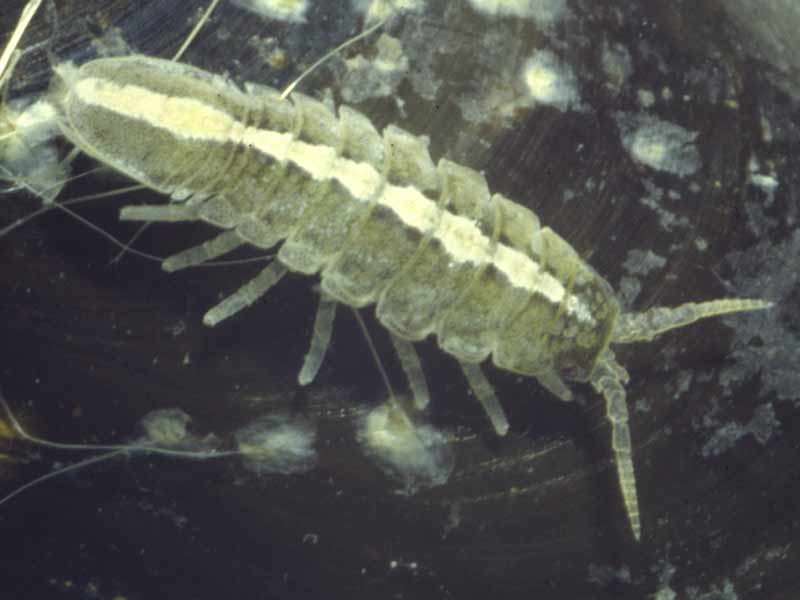A sea slater (Idotea pelagica)
Distribution data supplied by the Ocean Biodiversity Information System (OBIS). To interrogate UK data visit the NBN Atlas.Map Help
| Researched by | Dr Harvey Tyler-Walters | Refereed by | Admin |
| Authority | Leach, 1816 | ||
| Other common names | - | Synonyms | - |
Summary
Description
A dorso-ventrally flattened crustacean with an elongated rounded oblong shaped body. Body mostly dark purple to brown with white diamond-shaped patches or stripes down the midline and white markings along the edges of the body. Females tend to be darker than males. Males range in length from 4-11 mm and females from 7-10 mm. The distinctive head bears two dorso-lateral eyes, a pair of short antennules, and a pair of antennae. Most of body is taken up by a thorax composed on seven sections (somites). The body ends in a short abdomen (two somites) and a distinct tail-piece (the pleotelson). The antennule extend to the third segment of the antenna. The antenna is robust with a short flagellum that is densley covered with hairs in males. The pleotelson in adults is characteristic, with straight or slightly convex sides, a rounded end and only an indistinct middle tooth or process.
Recorded distribution in Britain and Ireland
Probably distributed all around the coasts of Britain and Ireland but poorly represented in surveys.Global distribution
Recorded form Norway to the French coast but not entering low salinity waters of the inner Baltic.Habitat
Found on wave exposed rocky shores amongst barnacles, mussels and stunted fucoids.Depth range
-Identifying features
- Dorso-ventrally flattened and oblong, oval body.
- Abdomen (pleon) consists of two complete somites and one partial suture.
- Antennule just or equal in length to the third section of the antenna.
- Antennal flagellum shorter than its peduncle, less than one sixth of the body length, and densely covered in hairs in males.
- Pleotelson sides straight or slightly convex, rounded with only an indistinct, blunt tooth.
- Tops of the legs bear broad coxal plates that widen posteriorly.
- Legs are very robust and bear a relatively larger claw than other Idotea.
Additional information
No text entered
Listed by
- none -
Bibliography
Bruce, J.R., Colman, J.S. & Jones, N.S., 1963. Marine fauna of the Isle of Man. Liverpool: Liverpool University Press.
Hayward, P., Nelson-Smith, T. & Shields, C. 1996. Collins pocket guide. Sea shore of Britain and northern Europe. London: HarperCollins.
Hayward, P.J. & Ryland, J.S. (ed.) 1995b. Handbook of the marine fauna of North-West Europe. Oxford: Oxford University Press.
Healy, B. & O'Neill, M. 1984. The life cycle and population dynamics of Idotea pelagica and I. granulosa (Isopoda: Valvifera) in South-East Ireland. Journal of the Marine Biological Association of the United Kingdom, 64(1), 21-33
Kroer, N. 1986. Distribution and habitat segregation of four species of Idotea (Isopoda) in a Danish fjord. Ophelia, 25(3), 199-207
Leifsson, B.R. 1999. The life cycle and population dynamics of Idotea pelagica and I. granulosa (Isopoda: Valvifera) in South-East Ireland. Sarsia, 83(1), 1-13
MBA (Marine Biological Association), 1957. Plymouth Marine Fauna. Plymouth: Marine Biological Association of the United Kingdom.
Naylor, E. 1955. The ecological distribution of British species of Idotea Journal of Animal Ecology
Naylor, E., 1972. British marine isopods. London: Academic Press. [Synopses of the British Fauna, no. 3.]
Picton, B.E. & Costello, M.J., 1998. BioMar biotope viewer: a guide to marine habitats, fauna and flora of Britain and Ireland. [CD-ROM] Environmental Sciences Unit, Trinity College, Dublin.
Sheader, M. 1977. The breeding biology of Idotea pelagica (Isopoda : Valvifera) with notes on the occurrence and biology of its parasite Clypeoniscus hanseni (Isopoda : Epicaridea) Journal of the Marine Biological Association of the United Kingdom, 57(3), 659-674.
Datasets
Environmental Records Information Centre North East, 2018. ERIC NE Combined dataset to 2017. Occurrence dataset: http://www.ericnortheast.org.ukl accessed via NBNAtlas.org on 2018-09-38
NBN (National Biodiversity Network) Atlas. Available from: https://www.nbnatlas.org.
OBIS (Ocean Biodiversity Information System), 2025. Global map of species distribution using gridded data. Available from: Ocean Biogeographic Information System. www.iobis.org. Accessed: 2025-08-05
Citation
This review can be cited as:
Last Updated: 23/05/2005



